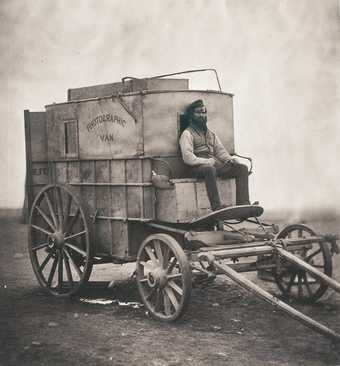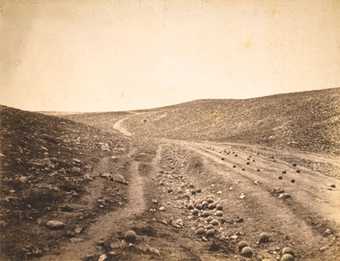Roger Fenton arrived in Balaklava harbour on a cool spring day on 8 March 1855. Sent out by the commercial firm of Thomas Agnews & Co to take photographs of the Crimean War, he brought with him a large white horse-drawn van, which had been converted from a wine merchant’s vehicle into a mobile darkroom. It had everything he needed – five large cameras, 700 glass plates stacked in wooden boxes, several chests of chemicals, printing frames, as well as his personal supply of preserved meats, wine, beer, biscuits and horse tackle.
A trained painter and the wealthy son of a Lancashire MP, Fenton (1819–1869) had turned his interests to the relatively new technology of photography and learned quickly. He exhibited his first photographs in 1852, co-founded the Photographic Society a year later and by the time he arrived in the Crimea had already received much valuable patronage from Queen Victoria and Prince Albert.

Roger Fenton
Fenton's Photographic Van with assistant Marcus Sparling 1855
© Courtesy Wilson Centre for Photography
While the sight of soldiers with a sketchbook as well as the occasional artist was not uncommon in the Crimea, the idea of a photographer ‘at the seat of war’ was new. Consequently, Fenton was pestered by troops wanting their ‘likeness’ taken, so much so that he noted he would ‘dread the sight of English officers riding up to my van’.
Agnews was relying on his images to make the company a profit, and aimed to sell them to soldiers, their families and any others. As Victorian taste decreed that no dead bodies be shown, Fenton had to choose his subject matter carefully. Helped by his letters of introduction to top-ranking officers, he quickly established good contacts who would advise him on the best places to take pictures. Following several weeks taking shots of soldiers, Balaklava harbour and army camps, he asked a friend to show him a good view. After a couple of miles they arrived at a narrow ravine that ran between the British camps on the plains and the Russian fortifications. What he came across stunned him: ‘Round shot and shell lay like a stream at the bottom of the hollow all the way down; you could not walk without treading upon them.’ He had arrived at what the soldiers had christened The Valley of the Shadow of Death – the name taken from the 23rd Psalm, and so called on account of the number of Russian cannonballs that landed short of their targets. To the troops and the hordes of tourists that travelled to the Crimea to watch the war, it was a well-known spot. One officer, Sir John Burgoyne, noted that the place ‘is a thing I always recommend an amateur to go and look at’.
Fenton immediately recognised the potential for a good photograph and returned a couple of weeks later. It was a dangerous time to go. The siege of Sevastopol was intensifying and cannon fire was regular. He described his second visit in a letter to his wife Grace:
I took the van down nearly as far as I intended it to go & then went forward to find out the chosen spot. I had scarcely started when a dash up of dust behind the battery before us showed something was on the road to us, we could not see it but another flirt of earth nearer showed that it was coming straight & in a moment we saw it bounding up towards us. It turned off when near & where it went I did not see as a shell came over about the same spot, knocked it [sic] fuse out & joined the mass of its brethren without bursting. It was plain that the line of fire was upon the very spot I had chosen, so very reluctantly I put up with another reach of the valley about 100 yards short of the best point. I brought the van down & fixed the camera & while levelling it another ball came in a more slanting direction touching the rear of the battery as the others but instead of coming up the road bounded on to the hill on our left about 50 yards from us & came down right to us stopping at our feet. I picked it up, put it into the van & hope to make you a present of it.
As well as risking his life, Fenton had to overcome many practical difficulties. He was using the wet-plate collodion process, which, although it produced high quality prints, was sensitive and unstable. A glass plate had to be dipped in collodion (a solution of guncotton, alcohol and ether), which was then sensitised with a coating of distilled water and silver nitrate. The plate was now ready for the camera. Once the picture was taken, the plate, still damp, had to be developed very quickly. Fenton had used this method many times before on his trips around England in the van. In English weather the plates stayed damp for ten minutes, but the heat of the Crimea could easily bring out spots and streaks on the glass. Dust and flies were also a problem, as he explained to Grace: ‘Before preparing a plate, the first thing to be done was to battle with them [flies] for possession of the place; the necessary buffeting with handkerchiefs and towels having taken place, and the intruders being expelled, the moment the last one was out, the door had to be rapidly closed for fear of a fresh invasion and then some time to be allowed for the dust thus raised to settle before coating a plate.’ However, with the van door closed, the temperature inside shot up and ‘perspiration started from every pore’. Every surface was hot to the touch and the heat could send the stoppers flying out of the bottles, as if they ‘had been laid on the hot bars of a fireplace’.
Despite these conditions, Fenton managed to take around 360 shots in less than three months, and on 26 June he returned to England. The photographs went on show at the Water Colour Society in Pall Mall in September, the first of three London venues. Versions of the exhibition then toured around the country for eight months, taking in Manchester, Leeds, Liverpool, Birmingham and Yeovil. They were a huge success. The critic of The Times felt that he had seen “nothing at all comparable in importance”. Another wrote with emotion of the sense of ‘palpable reality’ that the photographs suggested. Among the portraits of the gaunt-looking soldiers and the landscape scenes, commentators focused on The Valley of the Shadow of Death. One described the image as hell-like, an area ‘rough with shot, and bare, stony and blasted as an accursed and unholy place’, while another wrote that it ‘raises melancholy thoughts of the rude trials to which our brave countrymen and allies have been subjected for a whole dreary year’. While audiences were more accustomed to smoke-filled battle scenes, often done by studio painters creating a propaganda picture based on a second-hand account from a returning soldier, Fenton’s minimal approach coincided with a new feeling of empathy towards the military. Fuelled by William Howard Russell’s reports in The Times of the terrible conditions that troops had faced, Fenton had touched on an appetite for documentary – for telling it how it was, even if he was not explicit about the body count. His images acquired particular gravitas as he had been a witness to the misery of war (though rarely at close quarters). Several of his friends had died, and his brother-in-law Edmund had been injured. As the critic of the Art Journal wrote: ‘There is nothing of the beautiful, but the beautiful of reality.’
Fenton’s image became an icon – a ghostly reminder of the war dead. But the version we usually see today, with the cannonballs scattered across the road, is not the only one. In another, they are placed to one side, making the road look emptier. Fenton’s work was praised on account of its faithful representation of the scenes, but did he move the balls to get a better picture? (In a letter he notes that he spent one and a half hours and ‘got two good pictures’.) From the medium’s beginnings, photographers have manipulated a scene to get the required results. Two years after Fenton took this picture, Felice Beato distributed the human bones he found in a courtyard at the Sikandarbagh Palace for one of his photographs of the 1857 Sepoy Rebellion in India. Similarly, in their famous photograph of a field of dead soldiers at Gettysburg, Alexander Gardner and Timothy O’Sullivan, rearranged the bodies. But looking at these pictures now, does this matter?
While Beato, Gardner and O’Sullivan launched the beginning of a more graphic kind of photojournalism (seen recently in Kenneth Jarecke’s image of the charred Iraqi soldier, or Ron Haviv’s pictures of ethnic cleansing in Bosnia), Fenton introduced an alternative representation of war – the landscape of aftermath. It was an aesthetic of reduction that would appeal to future artists. As official war artists of the First World War, the most evocative paintings that Paul Nash and C.R.W. Nevinson produced were the devastated landscapes of the trenches – places where any human remains had been blasted to merge with the mud. As with Fenton’s barren road, in Nash’s Void of War 1918 and Nevinson’s A Flooded Trench on the Yser 1916, the routes lead nowhere and the scenes are stripped of man and nature. More recently, in Paul Seawright’s photograph based on his visit to the sites of exploded ordinance and mines in Afghanistan, a cluster of spent shells from an allied bomb attack lies on a dusty track. It is a picture of a contaminated landscape – a more reflective alternative amid the clamour of imagery that we are now fed by television news.

